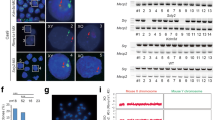Abstract
We assessed the role of acentric chromosome fragments in gene amplification by using cell fusion techniques to introduce the fragmented chromosomes of a donor Chinese hamster ovary (CHO) cell line that contained the dihydrofolate reductase (dhfr)gene(s) into a CHO cell line deficient for dhfr.Chromosome fragments were successfully integrated into cells at a frequency of approximately 3%. Methotrexate-resistant variants arose much more frequently in two cell lines derived from these successful cell fusions than in wild-type CHO cells. The hybrid cell lines also amplified their dhfrgenes more readily than did the CHO cell line used as dhfrdonor.
Similar content being viewed by others
Literature cited
Hamlin, J.L., Milbrant, J.D., Heintz, N.H., and Azizkhan, J.C. (1984).Int. Rev. Cytol. 90:31–82.
Akerblom, L., Ehernberg, A., Graslund, A., Lankinen, H., Reichard, P., and Thelander, L. (1981).Proc. Natl. Acad. Sci. 78:2159–2163.
Alt, F.W., Kellems, R.E., Bertino, J.R., and Schimke, R.T. (1978).J. Biol. Chem. 253:1357–1370.
Lavi, S. (1981).Proc. Natl. Acad. Sci. U.S.A. 78:6144–6148.
Shen, D.-W., Fojo, A., Chin, J.E., Roninson, I.B., Richert, N., Pastan, I., and Gottesman, M.M. (1986).Science 232:643–645.
Wahl, G.M., Padgett, R.A., and Stark, G.R. (1979).J. Biol. Chem. 254:8679–8689.
Yeung, C.-Y., Ingolia, D.E., Bobonis, C., Dunbar, B.S., Riser, M.E., Siciliano, M.J., and Kellems, R.E. (1983).J. Biol. Chem. 258:8338–8345.
Flintoff, W.F., Livingston, E., Duff, C., and Worton, R.G. (1984).Mol. Cell. Biol. 4:69–76.
Kaufman, R.J., Sharp, P.A., and Latt, S.A. (1983).Mol. Cell. Biol. 3:699–711.
Mariani, B.D., and Schimke, R.T. (1984).J. Biol. Chem. 259:1901–1910.
Roberts, J.M., Buck, L.B., and Axel, R. (1983).Cell 33:53–63.
Schimke, R.T., Sherwood, S.W., Hill, A.B., and Johnston, R.N. (1986).Proc. Natl. Acad. Sci. U.S.A. 83:2157–2161.
Varshavsky, A. (1981).Cell 25:561–572.
Botchan, M., Topp, W., and Sambrook, J. (1978).Cold Spring Harbor Symp. Quant. Biol. 43:709–719.
Lau, Y.-F., and Kan, Y.W. (1983).Proc. Natl. Acad. Sci. U.S.A. 80:5225–5229.
Morgan, W.F., Bodycote, J., Fero, M.L., Hahn, P.J., Kapp, L.N., Pantelias, G.E., and Painter, R.B. (1986).Chromosoma 93:191–196.
Hahn, P., Kapp, L.N., Morgan, W.F., and Painter, R.B. (1986).Cancer Res. 46:4607–4612.
Urlaub, G., and Chasin, L.A. (1980).Proc. Natl. Acad. Sci. U.S.A. 77:4216–4220.
Cirullo, R.E., Dana, S., and Wasmuth, J.J. (1983).Mol. Cell. Biol. 3:892–902.
Norwood, T.H., and Zeigler, C.J. (1982). InTechniques in Somatic Cell Genetics, (ed.) Shay, J. (Plenum Press, New York), pp. 35–45.
Southern, E.M. (1975)J. Mol. Biol. 98:503–517.
Carothers, A.M., Urlaub, G., Ellis, N., and Chasin, L.A. (1983).Nucleic Acids Res. 11:1997–2012.
Yunis, J.J., Soreng, A.L., and Bowe, A.E. (1987).Oncogene 1:59–69.
Biedler, J.L., (1982). InGene Amplification, (ed.) Schimke, R.T. (Cold Spring Harbor Laboratory, Cold Spring Harbor, New York), pp. 39–45.
Meinkoth, J., Killary, A.M., Fournier, R.E.K., and Wahl, G.M. (1987).Mol. Cell. Biol. 7:1415–1424.
Wahl, G.M., Robert de Saint Vincent, B., and DeRose, M.L. (1984).Nature 307:516–520.
Stankowski, L.F., Jr., and Hsie, A.W. (1986).Radiat. Res. 105:37–48.
Sager, R., Gadi, I.K., Stephens, L., and Grabowy, C.T. (1985).Proc. Natl. Acad. Sci. U.S.A. 82:7015–7019.
Giulotto, E., Knights, C., and Stark, G.R. (1987).Cell 48:837–845.
Barsoum, J., and Varshavsky, A. (1983).Proc. Natl. Acad. Sci. U.S.A. 80:5330–5334.
Author information
Authors and Affiliations
Rights and permissions
About this article
Cite this article
Hahn, P., Morgan, W.F. & Painter, R.B. The role of acentric chromosome fragments in gene amplification. Somat Cell Mol Genet 13, 597–608 (1987). https://doi.org/10.1007/BF01534480
Received:
Revised:
Issue Date:
DOI: https://doi.org/10.1007/BF01534480




